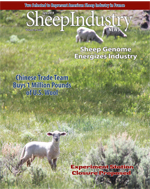
- July 2014
- President’s Notes
- Market Report
- ASI 150th Anniversary Blankets & Pillows Now Available
- Sheep Genome Excites Industry
- Closure of Sheep Experiment Station Proposed
- Industry News Briefs
- Support For Wildlife Services Moves Forward as Appropriations Vote Nears
- Chinese Buyers Get U.S. Wool Close-Up
- ASI Sending Pair of Young Shepherds to France to Compete in 2nd World Ovinpiades
- ASI Photo Contest Seeks Your Best Shots
To View the July 2014 Digital Issue — Click Here
Sheep Production Was Big Part of Building Regional Economies
One of the things I found interesting in researching the history of sheep in the United States is the important role they played in developing a textile industry. It was considerably more than just providing clothing; it was one of the real drivers of the economies of the various regions, because of the jobs which were created. People were required to have sheep in some areas, just to insure the success of their local economies.
Because sheep were being used to create strong economies, they were moved westward rapidly from 1850 to 1900 with the settling of the territories in the west.
All of the soldiers in the Civil War wore wool uniforms (probably wool everything else), and I suspect the percentage of wool clothing in the general population was quite high. I doubt very many homes had forced air heating.
The demand for wool to replace cotton, caused by the disruption of the Civil War, along with the westward expansion of the railways, spread sheep from the East and Midwest, into Missouri, Iowa, Wisconsin and Minnesota. In 1860, the states of Ohio, New York, Pennsylvania, Wisconsin and California were the five largest sheep producing states, followed by Virginia, West Virginia, Kentucky, Indiana, Missouri and New Mexico. Ninety years later, the five largest sheep producing states were Texas, California, Utah, Wyoming and Montana, followed by Idaho, Colorado, South Dakota, Missouri and Ohio.
As sheep moved west and north into the territories, production improved, and midway through the last half of the 1900s, the emphasis began changing from wool to meat production. Breeds such as the Cotswold, Hampshire, Dorset and others were introduced, and a lamb feeding industry was started in Kansas, Nebraska and Minnesota.
After the Civil War, the demand for meat, and the ability of the railroads to deliver animals to urban centers, coupled with falling wool prices because of the availability of cotton once again, were the drivers which ultimately shaped the industry we see today.
This rapid increase in sheep numbers from 1850 to 1900 was brought on not only by settlers moving into new territories, but also by changing management practices. Producers started herding sheep in large bands across the non-homesteaded lands of the west. (Okay, maybe they occasionally crossed one or two homesteads) Sheep trails were established. Machine shearing was replacing blade shearing.
By 1900, Oregon had over 3 million sheep, and a wool textile industry. California had 2.5 million sheep and Washington nearly 1 million.
But these sheep were the beginning of the dual purpose sheep, producing both meat and wool. Breeds such as the Columbia, Panama and Targhee were developed to help increase the production of both quality wool and quality meat.
In the 1880s, Texas began fencing sheep, which was heavily opposed by cattleman who felt grazing should be free for everyone.
In the 1890s, Arizona developed a system of wintering sheep on irrigated alfalfa and Utah evolved a system of wintering sheep on the desert. The last western states settled with sheep were Colorado and the Dakotas, but their numbers would grow rapidly with imports from Oregon and New Mexico.
Sheep numbers in the U.S. reached their peak of 52 million in 1882.

